Elden Ring Elevates Souls-likes Further Than Before
The Souls-like genre goes open-world

From Software still holds the crown as the company that created, refined, and made the best Souls-like games throughout the 2010s. Dark Souls pushed their formula, first conceived with King’s Field and then Demon’s Souls into a wider, but not open world. Since then, the company has iterated on the design and while we can certainly rank the games in terms of quality, the Soulsborne franchise has stood in a league of its own. Despite many competitors over the 2010s, no one has managed to out-Souls the folks at From Software. And they have may have gotten even further out of the reach of other studios with Elden Ring — taking elements of their previous games and moving into an open world.
Ringing in the World
Elden Ring’s story continues From Software’s tradition of telling you very little and a lot all at once. The world has been devastated following the destruction of the Elden ring, with its various pieces now held by your upcoming boss fights. As a tarnished, or lowest-class person in the world, it’s up to you to become a lord by collecting the pieces.
After a brief introduction, you are treated to the most radical departure and addition to the Souls-like formula yet: a completely open world. This is not the same as the Dark Souls trilogy, where there was a mostly linear path to follow. The entire game space is open to you from the very beginning to explore at your leisure. The overworld itself has its own biomes, complete with enemies and points of interest to find. Elden Ring's version of a Dark Souls level is the ruins and dungeons that litter the world. Some are very short, while others can take you hours to explore.
To guide you, sites of lost grace litter the map and are both Elden Ring’s bonfires and fast travel points — and you can fast travel from the very beginning. Another big change, and one that really helps at the start, is your spectral horse Torrent who gets unlocked after exploring the first area. With Torrent, not only can you move faster across the world, but you can fight on horseback and even double jump with him. That’s right, jumping is now a core component of moving around the world as opposed to something that was incredibly awkward in the other games.
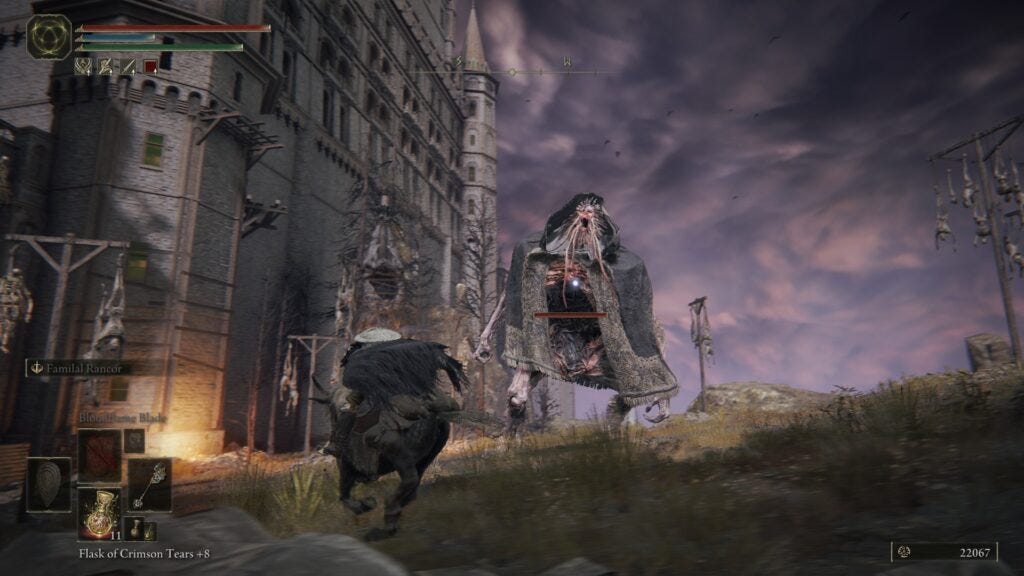
Horseback riding and fighting not only make the open world more interesting but radically changes the difficulty of the game. While on Torrent, you move faster to where you can perform hit-and-run maneuvers on any enemy, including wandering mini-bosses. The downside is that Torrent is inaccessible in the game’s dungeons, and taking too much damage will knock you off your mount.
You’re going to need every advantage you get, as Elden Ring is both easier and harder than previous games.
Git Exploring
The Internet has argued much since its release whether Elden Ring is the easiest or hardest Souls-like to date. Like From Software’s other departure from their formula: Sekiro, if you try to play Elden Ring exactly like the Dark Souls games, you’re in for a rude surprise. Trying to follow the main path right at the start is basically asking for trouble, as levels and gear are going to be limited. Mini-dungeons can drop specific resources, gear, and upgrade materials, and there are treasure chests hidden throughout the world that can provide you with more gear.
Just like a lot of western-focused RPGs and open-world design, your best bet is to look out over the world for anything that looks cool or interesting and just go there. As a completely non-spoilery starting guide for new players, follow these three tips:
- Follow the lost grace points to unlock your horse
- Whenever possible, be riding while in combat to give you more maneuverability and survivability
- Get to the castle gates and use the grace point in order to unlock an important and useful hub
One of the early upgrades that you can miss is the ability to summon your own team of spectral helpers for boss fights and fighting groups of enemies on the map when playing without online helpers. This is not like Dark Souls where enemy groups were designed to be small to compensate for the smaller play spaces. One of the most welcomed changes is that you can get free estus recovery for clearing out groups of enemies — allowing you to keep pushing forward into new areas.
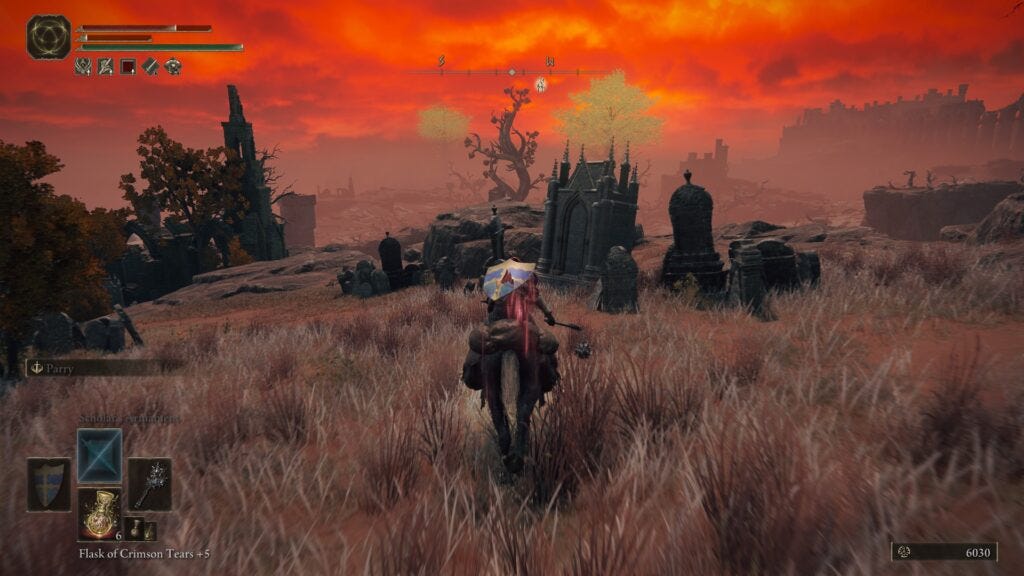
While developers have upped the general difficulty across the board, especially with the starting boss fights, Elden Ring gives you far more options and utility than any previous Soulsborne title. The linearity of previous games meant your options were very limited if you got stuck in a mission-critical area. Here, there is always another area, dungeon, piece of the map, etc. to explore. This is also not a game that will make the starting area easy for you. There are at least two boss encounters within close distance of your starting area that aren't meant to be tackled until later in the game.
Now comes the other big question: Does Elden Ring make all this work?
Ring Around the Rosy
As someone who loves the Souls-like formula, but is not a huge open-world fan, I feel Elden Rings checks two of the three gameplay boxes that it’s trying to fill.
The moment-to-moment gameplay is still amazing. Elden Ring’s combat is very much an evolved version of the systems in Dark Souls 3, with every weapon having a corresponding “art” that you can use in combat. There are now other tactics you can use to break an enemy’s posture, including a jump attack and a block counter on top of parrying. You can unlock the ability to change arts and put new ones on your weapons. The variety of weapons all feel different, and I’m sure you could have a different experience playing the game focusing on each one, or building to suit different stats. Between the weapons, craftable items, magic, and summoning, there are far more ways to play this game compared to any other Souls-like on the market. If you’re good at the game, you can effectively make a beeline straight for the first castle and conquer it with little trouble.
The enemy designs are more advanced, with many bosses and enemies given far more moves and longer combo patterns. Enemies also have far more “trick patterns” where a combo can end in different ways to trap you into thinking that it’s safe to go in. I can only imagine the challenges that hardcore players are going to set up for themselves and I do not envy anyone who wants to attempt a “no-hit run” of Elden Ring.
Exploring the world for points of interest and new dungeons is a great feeling, and this is the first time in an RPG for me where it felt great to wander around to find some cool/nightmarish area. On a lark, I found a mysterious building that didn’t look all that impressive, which then led to a massive underground world to explore. While Elden Ring has areas that are going to rock you in terms of stats, this is not the same as other RPGs with artificial gates, where if you’re not at level X, you literally can’t make any progress. It is quite possible, and fun, to sneak around dangerous areas looking for resources, chests, and mini-dungeons.
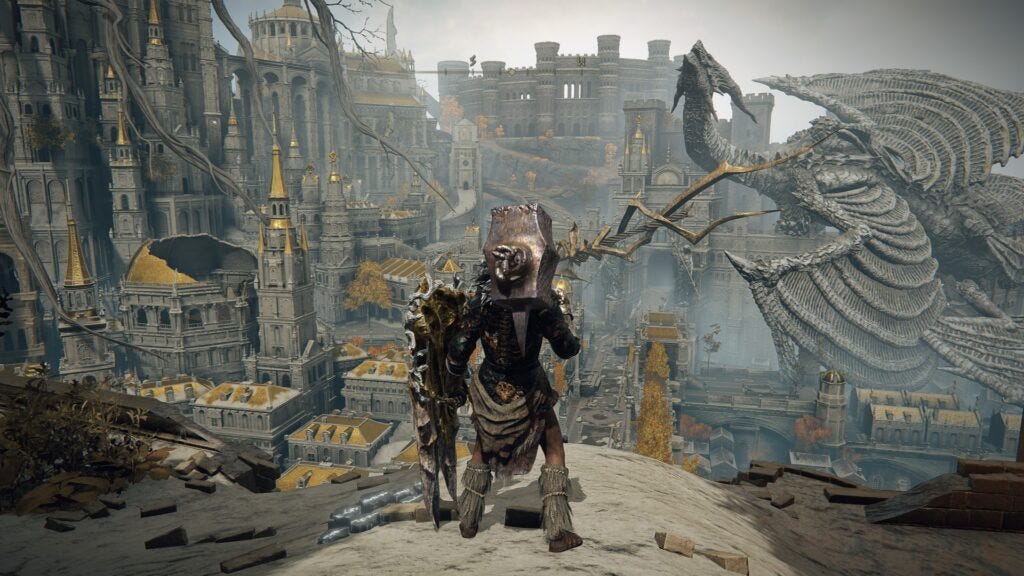
While they filled most of the open world with minor enemies that aren’t worth many runes (the game’s version of souls), there are places you’ll find that you can farm quite nicely. This is one of those games where you’re not really supposed to beat your head against the wall to beat a fight. Either there’s another way or another area that you can explore.
With that said, there is one area I feel that Elden Ring is a bit of a letdown for me, and all of you reading this are going to hate what I’m about to type. I feel Elden Ring’s world is soulless.
A Painful Trip
When I think about open-world design and what I want to see from it, there are two distinct gameplay loops:
- The player is able to explore and manipulate things through their own abilities (Breath of the Wild-style)
- The world moves at its own pace and can change as the player progresses
I know everyone is going to jump at the use of Torrent and being able to explore on horseback. However, your actual means of interacting and exploring are still basic. To me, the gold standards of movement and exploration in an open world are Sunset Overdrive and Breath of the Wild. Jumping is a huge deal in Elden Ring, but I wish that there were more ways of interacting with the world. There are many enemy emplacements set up that you can’t do anything with. Finding caravans along the main roads was a nice touch until I realized they were set up at fixed locations and not really random.
The issue is that I feel that the gameplay loop of Elden Ring and other Souls-likes clash with the act of exploration and progression in an open-world structure. When you play open-world games, every new dungeon or POI has the potential of upgrading your character — either short-term with new gear, or long-term with incremental upgrades to your stats. In a Souls-like, so much of your actual play is about figuring out what kind of build you want and focusing on it. One, because the cost of upgrading new gear becomes harder with limited resources for a long time, and two, switching to new weapons requires relearning the muscle memory and timing for using it.
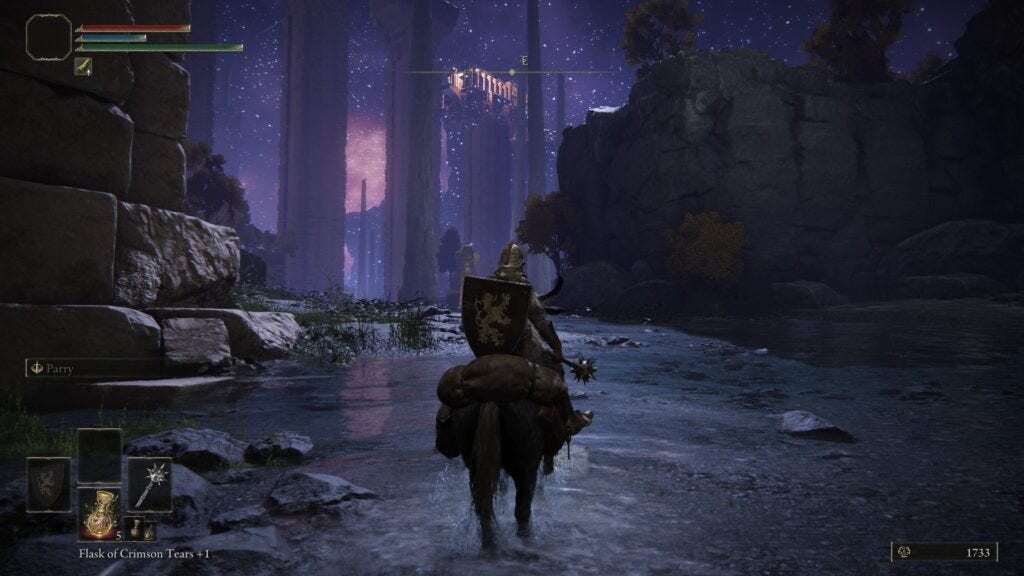
Elden Ring purposely forgoes a lot of the traditions of open-world design, but I feel they left a noticeable gap with this decision. At one point, I spent a little over two hours clearing everything I could from a region in the world using my strength-focused character, and of those areas, I found very little that actually acted as an upgrade, new gear, or anything I could use. If I clear out a town and get a spell or a faith-based weapon, that means nothing for my specific build. I could crawl my way through a difficult dungeon, fight the boss, and be rewarded with an item that I will never use for that character or will have any impact on my play.
Part of the problem is how the division of runes is applied. The difficulty of the enemy 9 times out of 10 does not correspond to the number of runes they’re worth. Fighting giant trolls in the first area is barely worth it compared to enemies in Caelid. Of course, the difficulty there is far higher, but it felt demoralizing to spend minutes fighting some epic enemy in the world to barely break 1,000 runes for my trouble.
In a controversial move, I’m thinking that the stat-based limitations of gear are holding things back. Because the cost of leveling up gets progressively more expensive, it makes it exponentially harder and more time-consuming to try a new weapon that your stats aren’t built for. This removes the incentive to try that crazy anchor that’s an ax or a dagger that spits blood at people. I think this is the kind of game where From Software should have tried to implement randomized passive upgrades and incremental progression, kind of like the equipment slotting you could do in Bloodborne. Using the talismans and great runes helps allow you to customize your build in different ways, but that creates an artificial limit to how many of each you can equip.
For someone wanting to see the sights, the world is one of the most interesting open-world designs I’ve seen in terms of environments, challenge, and variety. But I wish that there were more generalized rewards and progression tied to the act of exploration beyond just getting more runes or increasing your healing capacity. Using the ashes of war to modify weapons is a good touch, but only one slot per weapon once again greatly limits their use once you have an established build.
Cluttered Combat
And now it’s time for the point where I’m going to get the most pushback on Elden Ring: I think the improvements have, in a way, hurt the overall combat system of the game. Elden Ring has by far the most options for combat out of any previous Souls-like, but to capitalize on that, the developers have tweaked the AI in a direction I’m not a fan of.
For the previous games, including Bloodborne, melee was always the default option, with magic and range as backups. If you weren’t good at melee, you would not get far in these titles. With Elden Ring’s multiple ways of approaching combat, the developers have tuned the AI and combat where melee, or I should say, pure melee, is heavily punished. Mid- and up-sized enemies are less likely to be staggered outside of the new jumping attack, which heavily incentivizes continued use of it above all else. Out of all the games in the series, Elden Ring features some of the highest amounts of enemy tracking and wide swings. There are enemies who can turn 180 degrees in the middle of a combo string to smack you.

I’ve seen some people praise this on Twitter, saying things like "it makes combat more reactive", but I would argue the opposite. The enemies feel more predictable to me and far easier to exploit the AI based on the range you’re at. There are far too many enemies that you can only safely go in on melee after a specific pattern, as any other time is too dangerous.
The worst offender is the number of “wild combos” that enemies can do where they will just start swinging their weapon, sometimes over 6 hits in a single combo. If you’re trying to block, there is no way you’re going to have enough stamina to tank those hits, and if one gets you, most likely you’re going to get hit by the rest of it. This also creates a camera tracking nightmare when fighting large enemies who, of course, can start swinging and dashing around an arena. I believe the reason is to provide a kind of counter to the number of ways you can now fight enemies safely, but it hurts close-ranged combat where an enemy can just launch these attacks at any time.
The attacks are also so chaotic that it’s very hard to learn their patterns, with dodging and parrying being quite difficult to use well. The parry window in Elden Ring feels completely different from previous games and caused me a lot of trouble in terms of trying to relearn the muscle memory for it. I would say if you’re interested in focusing on dodging as your primary form of defense, do whatever you can to get down to light load and make use of the fastest roll available.
Because of this, it greatly increases the amount of time to fight enemies waiting for their safe patterns, and deemphasizes, for me, the combat system I’ve enjoyed in previous games. I feel that I’m fighting enemies that are faster and more reactive than in Bloodborne, while still being constrained by the slower combat and animation of the Dark Souls’ style. Further punishing the combat system is the number of group fights and multiple enemy boss fights that Elden Ring has compared with other games. As I’ve said prior, the combat system of these games always breaks in favor of the side with numbers, and the game is practically screaming at you to use summons in these sections. There are more group boss fights in Elden Ring than in all other Soulsborne games combined.
One of the most important tips is that you really need to invest in health due to the overall aggressiveness of the enemies. I found my interest in playing the game diminishing the further I got into it. I felt like there was nothing more I could do to progress as my build was set, other than to just keep raising health and FP, but the enemies continued to grow in power and annoyance. I can explain my issue with Elden Ring’s combat in one simple sentence: Melee combat, which has been the series’ bread and butter, is actively punished as a strategy as you enter the back half of the game. When the enemy can recover from their attack, start their next attack, and hit me before I can even finish swinging my weapon one time, something is not right.
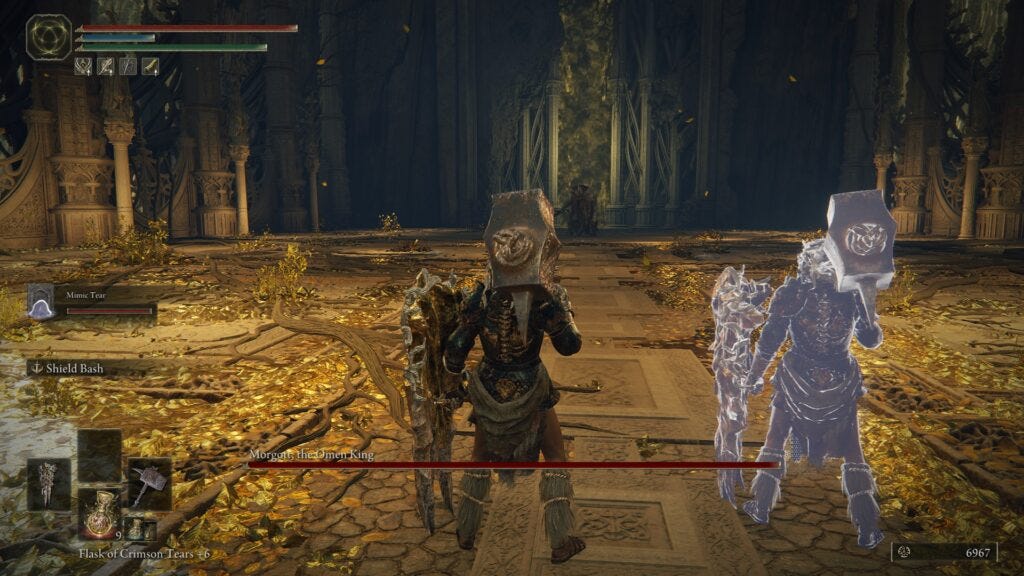
Mysterious Gameplay
For the final point, while everyone is praising the guideless direction that Elden Ring adopts compared to other open-world games, I think it may be too guideless at the start. There are already memes popping up about how people completely missed the combat tutorial at the start, but there is a greater issue. There are several major game systems and tools that are far too easy to miss, and it clashes with From Software’s insistence on the player just going out and exploring the world.
The hub that I mentioned a few sections ago requires you to do one specific task to unlock game critical options, like being able to upgrade your gear more. Depending on how much you go off the beaten path, you could find this out within 20 minutes of play, or over many hours. It is also too easy to miss out on the person who gives you the power of summoning spectrals, and both these events would have been fairer if their conditions weren’t as strict.
The game wants to have its cake and eat it too by saying, “go anywhere you want and explore” and “you must do exactly this to unlock system/service X.” In fact, by me purposely going off the beaten path, I missed a lot of important areas and points of interest by exploring the landscape. Trying to find a specific weapon that you want to use without using a guide or playing it a second time is a nightmare. I will also say for Dark Souls veterans, one of the biggest shifts you’ll need to make is utilizing the jump. This is not like the other games where jumping is an afterthought, there are plenty of paths that are going to look like just random jumps that you will need to do. And that is honestly not a bad thing, as it opens up the level design to be far more interesting with additional routes for speedrunners and non-speedrunners alike.
As you get further into the game, the open world wears thin, in my opinion. There is a lot of real estate that is just there to extend the time of traveling from painful point A to painful point B. There were more times than not that I completely missed lost grace points, even with the golden wisps in the air. When you get to the larger fixed areas, the level design is once again on point. I wish that the game would let you teleport in and out of areas at all grace points, as there are plenty of underground sections where teleporting is prohibited no matter what. Trying to remember quests or things you have to do in the world is a tremendous pain, with no quest log or ability to even recall conversations with NPCs.
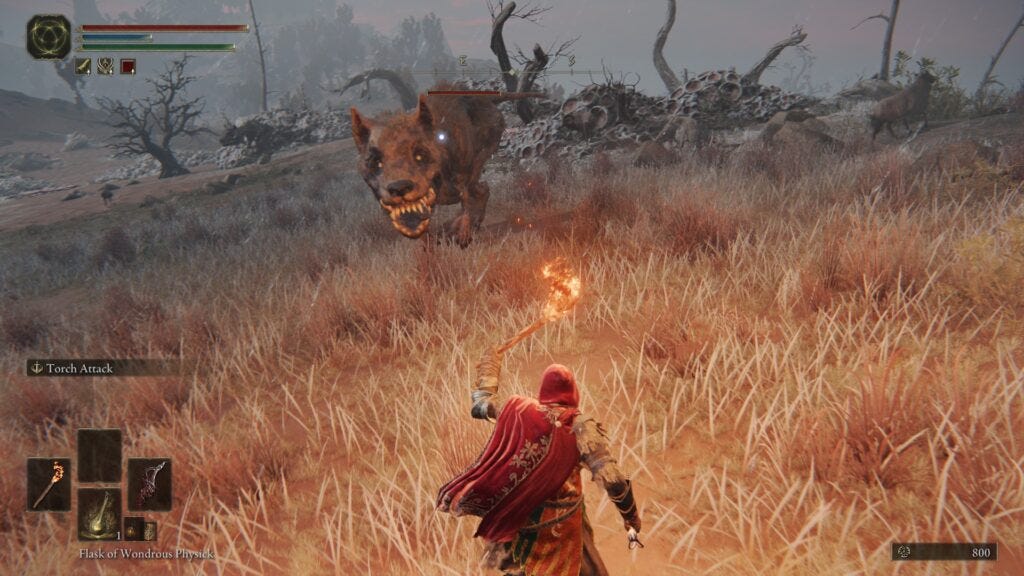
A Golden Ring
With everything said, Elden Ring may be the first open-world-focused RPG I enjoyed at least a little, and that means a lot coming from me. However, it’s going to be a bit of a stretch to get me to finish this game. From Software is to Souls-likes what Nintendo is to platformers, and I feel that a lot of developers are going to be taking heavy notes on Elden Ring for the future.
Similar to my thoughts on XCOM 2, I feel that Elden Ring is really close to being one of those perfect games for me, and like XCOM 2, certain design decisions keep it from that position. I’m definitely interested to see where From Software goes with this formula in the future. This is going to be the open-world game that a lot of titles are going to be judged against for some time, and this could be From Software’s magnum opus to date. I’m not as enamored with this game compared to other people, and my distaste for open-world design is stronger than my enjoyment of combat and progression.
If you were someone put off by the focus of linearity and progression of previous Souls-likes, Elden Ring may be the best game yet to dip your toes into.
If you enjoyed this story, consider joining the Game-Wisdom Discord channel. It’s open to everyone.
